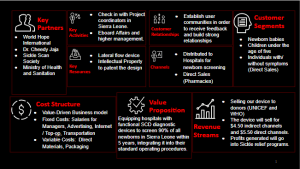- Step 1: Determine the facts in the situation – obtain all of the unbiased facts possible. Clearly state the ethical issue.
- Ten researchers traveling to Lesotho
- Traveling for two weeks
- Several publications expected from this research
- Need locals to show them water sources/methods
- Lesotho is an LMIC
- The specific pathogen only exists in this region of Lesotho
- This research could lead to the development of chemical additives to treat the drinking water
It is ethical to conduct this research.
The primary ethical issue is whether to pay the community members for their work in enabling the research.
- Step 2: Define the Stakeholders – those with a vested interest in the outcome
- Researchers
- Community members
- Residents of the region at large
- Academic institutions or other funding organizations
- National and regional government organizations
- Water purifying companies / NGOs
- Scientific community
- Step 3: Assess the motivations of the Stakeholders
-
- Researchers (primary stakeholders)
- Academic interest: understand the lifecycle and characteristics of a specific pathogen
- The desire for publications and academic prestige
- Implications for future work (sharing knowledge with the scientific community)
- Researchers (primary stakeholders)
- Altruism/humanitarianism (helping the community members)––Khanjan disagrees; the researchers are unlikely to be the same people developing the solution
- Community members (primary stakeholders)
- Curiosity about the researchers and their work
- Hope for better living conditions (safe drinking water)
- Want the pathogen to be understood
- Desire to draw attention to the issue
- The desire for financial compensation
- Residents of similar settings (the region at large; other places with related diseases)
- Hoping for better living conditions (safe drinking water)
- Possible transferability of results
- Safe drinking water makes real estate more appealing
- Backing organizations, even if not funding (secondary stakeholders)
- The desire for prestige/reputation
- Stability and safety of researchers
- Funding organizations (secondary stakeholders)
- Publications and prestige
- High-quality results
- National or regional government organizations (secondary stakeholders)
- Possibility of improved public health
- Networking opportunities and personal or organizational prestige
- Improved view of country/region on the world stag.
- The scientific community (secondary stakeholders)
- Understand the lifecycle and characteristics of the pathogen
- Implications for future work
- Altruism (helping community members)
- Step 4: Formulate (at least three) alternative solutions – based on information available, using basic ethical core values as a guide
- Approach 1: Pay the community members offering assistance
- Ethical Principle or code: Consequence-based thinking or duty-based thinking
- Pros:
- Recognizing the value that locals bring to the research
- Respecting locals’ time and efforts
- Cons:
- How to decide how to pay
- Expense
- Some cultures may be offended by a money offering
- Approach 2: Recruit community assistance as a volunteer opportunity
- Ethical Principle or code: Ethics of care
- Pros:
- Find people with the right motivations to assist you
- You will not offend anyone by offering money
- Volunteering is rewarding to them and will create trust
- Cons
- Can be time-consuming to find volunteers
- Approach 3: Compensate in a non-financial way
- Ethical Principle or code: Duty-based thinking
- Pros
- Exercising appropriate virtue by recognizing locals’ value
- Non-financial compensation may be more valuable to locals
- May incur fewer expenses
- Cons
- What is honest or virtuous depends on social traditions, history, etc.
- Deciding what the compensation will be
- Money is the easier option
The best approach would be Approach 2: Recruit community assistance as a volunteer opportunity.
Bypassing it to well-developed organizations in the country with interest that might align with the researcher’s goal, there is a chance of getting the help they need for free. By putting together an application site where people of interest get to learn about the true mission and what is going to be expected of them gives the venture a chance at getting the right person at no additional cost as long as they clearly state that it is a volunteer position. Part of this option creates a long-standing relationship with the institute that could prove useful later in the long run. This decision has no hindrance to the current plans for the researchers when executed well in advance of time.





